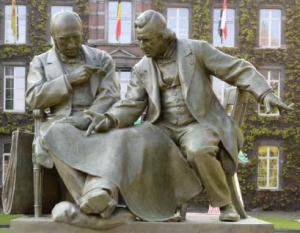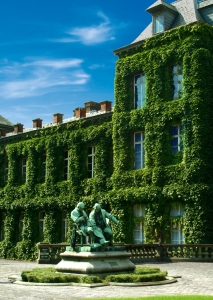History
From the École des Mines to the UMONS Faculty of Engineering
1837-2012 : 175 years
 They were young engineers, they were graduates of a great engineering school, and they were called Alphonse and Théophile. However, young engineers are no longer known by just their first names, and for good reason…
They were young engineers, they were graduates of a great engineering school, and they were called Alphonse and Théophile. However, young engineers are no longer known by just their first names, and for good reason…
It was the year 1837 and the provincial government of Hainaut decided to entrust Théophile Guibal and Adolphe Devillez with the responsibility of organising the course programmes of the newly created Provincial Mining School of Hainaut.
These two young engineers were from the Ecole Centrale des Arts et Manufactures de Paris, founded eight years before. On the first Monday of November 1837, together with two other colleagues, they welcomed their first students, who began a course of study fixed at two years in duration. The school saw its first four graduates in 1839.
Directors, Administrators, Rectors and Deans who became head of the Engineering Faculty of Mons from 1837 to the present day
- Adolphe Devillez, from 1837 to 1865, no title
- Adolphe Devillez, from 1866 to 1888, named Director for the first time
- M. Lambert, from 1888 to 1890, Temporary Director
- Auguste Macquet, from 1890 to 1918, Director
- Armand Halleux, from 1918 to 1923, Administrator
- Jules Yernaux, from 1923 to 1934, Administrator
- Jules Yernaux, from 1934 to 1946, Administrator-Director
- A.J. Jadot, from 1946 to 1952, Administrator
- Pierre Houzeau de Lehaie, from 1952 to 1954, Administrator
- Pierre Houzeau de Lehaie, from 1954 to 1970, named Rector for the first time
- Jean Baland, from 1970 to 1974, Rector
- René Emile Baland, from 1974 to 1986, Rector
- Christian Bouquegneau, from 1986 to 1994, Rector
- Serge Boucher, from 1994 to 2006, Rector
- Calogero Conti, from 2006 to 2009, Rector
- Paul Lybaert, from 2009 to 2014, Dean
- Pierre Dehombreux, from 2014 to 2018, Dean
- Christine Renotte, from 2018 to …, Dean
Collège de Houdain
 The Collège de Houdain was originally a college of humanities, founded in 1545 by the Magistrate of the City of Mons. Located in the old garden of the Houdain Hospital, the current building dates back to the first third of the 18th century, and was designed and rebuilt by architect Claude-J. de Bettignies, who also designed the belfry of St. Elizabeth, between 1735 and 1739. The original wing is crowned by a perforated belfry and dormers.
The Collège de Houdain was originally a college of humanities, founded in 1545 by the Magistrate of the City of Mons. Located in the old garden of the Houdain Hospital, the current building dates back to the first third of the 18th century, and was designed and rebuilt by architect Claude-J. de Bettignies, who also designed the belfry of St. Elizabeth, between 1735 and 1739. The original wing is crowned by a perforated belfry and dormers.
As it was integrated into the same building as the Hospital of the Holy Spirit and the Bureau de Bienfaisance (charity office), the college became referred to as the Holy Spirit. Following the closure of the college in 1794, the building was then occupied by workshops. The École des Mines took it over in 1878 and it was then that the central part and the current right wing were built by the architect Hector Puchot.
The bronze monument by L. Devillez was installed in 1902 in the centre of the courtyard, and represents Guibal and Devillez, the founders of the École des Mines.
Today, the former Collège de Houdain is part of the UMONS Faculty of Engineering (FPMs). A vast and imposing building, set over four floors, some of its main features include a ground floor adorned with a beautiful gallery of nine semi-circular arches, and a remarkable cast iron and granite staircase from Soignies.
In addition to being the historic site of the Faculty, these buildings house a museum space.
